j_sum1
Administrator
       
Posts: 6218
Registered: 4-10-2014
Location: Unmoved
Member Is Offline
Mood: Organised
|
|
Identification of unknown metal
I was looking for a couple of electrodes for water electrolysis today and came across a zip seal bag with some strips of shiny foil. Unlabelled.
If memory serves me well, they are tantalum, but I am not sure. I haven't had time to do much investigation but I csn tell you the following:
Lovely untarnished appearance.
Foil is quite malleable but also has a certain twangines of a high modulus of elasticity. (Not as high as Mo, but close.)
Performed electrolysis of alkaline solution at high current density with no change in appearance.
Completely unreactive with HCl
Unreactive with concentrated nitric acid at room temp.
Reacted with boiling nitric acid producing a pale, almost lemon yellow solution.
This rules out Ni which was another possibility. (I do have some similar nickel foils somewhere but they are not as bright looking if I recall
correctly.)
Any good suggestions to confirm my suspicion that these are Ta?
|
|
|
itsallgoodjames
Hazard to Others
  
Posts: 276
Registered: 31-8-2020
Location: America Lite
Member Is Offline
|
|
Something to always try when identifying an unknown metal is to see if it sticks to a magnet.
Tantalum should be mostly unreactive with aqua regia, but will dissolve in hydrofluoric acid. If you have access to HF, that could be something to
try
|
|
|
Bedlasky
International Hazard
    
Posts: 1219
Registered: 15-4-2019
Location: Period 5, group 6
Member Is Offline
Mood: Volatile
|
|
Look here:
https://books.google.cz/books?id=VTP-BAAAQBAJ&pg=PA24&am...
|
|
|
Metallophile
Hazard to Self
 
Posts: 82
Registered: 23-3-2018
Member Is Offline
Mood: No Mood
|
|
Maybe flame spectroscopy?
|
|
|
Herr Haber
International Hazard
    
Posts: 1236
Registered: 29-1-2016
Member Is Offline
Mood: No Mood
|
|
Tantalum is DENSE.
Got 2x10 grams in different forms and though it doesnt look like much it weights almost as much as gold.
The spirit of adventure was upon me. Having nitric acid and copper, I had only to learn what the words 'act upon' meant. - Ira Remsen
|
|
|
1KEE
Harmless

Posts: 25
Registered: 23-2-2020
Member Is Offline
|
|
Tantalum tends to be grey, or bluish grey. It’s very ductile/malleable, not very springy. And it’s very dense. I’ll try to find my sample and
take a photo of it tomorrow... any chance you could get a density measurement?
Machinists hate the stuff as it’s gummy and cuts like pure annealed copper.
[Edited on 10-15-2020 by 1KEE]
|
|
|
MidLifeChemist
Hazard to Others
  
Posts: 192
Registered: 4-7-2019
Location: West Coast USA
Member Is Offline
Mood: precipitatory
|
|
I think a density measurement would be very useful.
|
|
|
j_sum1
Administrator
       
Posts: 6218
Registered: 4-10-2014
Location: Unmoved
Member Is Offline
Mood: Organised
|
|
Thanks for the suggestions. Keep them coming.
My issue with density is that the samples are very small strips of foil and I do not have either a micrometer or scales accurate enough to use teh
displacement method.
Next will be to pop it into a flame and test its refractory properties and see if oxide is formed.
That and have a closer read of the link that Bedlasky provided.
I might look at oxidising / reducing the solutions I have and see if I get some different colours. But I need to do some research first. I
understand that oxidation states of 3, 4, and 5 are possible for Ta. But I am not sure what colours to expect or what my nitric acid soltions are
comprised of.
The other big idea will be to search around for a label that has fallen off. It is not like me to have these things unlabelled. But that does take
away some of the fun.
I also have another piece of Ta turnings for comparison.
|
|
|
DraconicAcid
International Hazard
    
Posts: 4278
Registered: 1-2-2013
Location: The tiniest college campus ever....
Member Is Offline
Mood: Semi-victorious.
|
|
Quote: Originally posted by j_sum1  | | I understand that oxidation states of 3, 4, and 5 are possible for Ta. But I am not sure what colours to expect or what my nitric acid soltions are
comprised of. |
I think you'll find that +5 is the only stable oxidation state of Ta, and I would expect that to form a colourless solution.
Please remember: "Filtrate" is not a verb.
Write up your lab reports the way your instructor wants them, not the way your ex-instructor wants them.
|
|
|
Bedlasky
International Hazard
    
Posts: 1219
Registered: 15-4-2019
Location: Period 5, group 6
Member Is Offline
Mood: Volatile
|
|
j_sum1: Reducing Ta(V) in to lower oxidation states isn't possible in solution. This compounds are (according to Remy) produced by reduction of TaCl5
with aluminium powder (using small amount of AlCl3 for easier start of reaction) in vacuum at 300°C:
3TaCl5 + 2Al --> 3TaCl3 + 2AlCl3
TaCl3 + TaCl5 <--> 2TaCl4
If you distill excess of TaCl5 at 350-400°C, you get pure TaCl3.
If you heat TaCl3 in vacuum at 500-600°C, you get TaCl2:
3 TaCl3 <--> 2TaCl2 + TaCl5
All chlorides are green in colour, solids at room temperature. TaCl4 undergoes dissproportionation is solution, while TaCl3 just dissolve:
4TaCl4 + 5H2O --> 2TaCl3 + Ta2O5 + 10HCl
On the other hand, niobates can be reduced in acidic solution in to Nb3+ using zinc powder.
This is general trend among transition elements in periodic table. The lower the metal is in periodic table (and the further to left), the hardly it
can be reduce it in to lower oxidation states in solution. For example:
Ti(IV) can be reduced in to Ti(III), but Zr(IV) and Hf(IV) can't.
V(V) can be reduced in to V(II), Nb(V) in to Nb(III), Ta(V) can't.
Cr(VI) can be reduced in to Cr(II), Mo(VI) in to Mo(III), W(VI) in to W(V)
Btw: Thanks for inspiration  . Without your question I didn't read about Nb(V)
reduction. I probably buy few grams, dissolve some of it in NaF/HNO3 mixture and reduce it with zinc . Without your question I didn't read about Nb(V)
reduction. I probably buy few grams, dissolve some of it in NaF/HNO3 mixture and reduce it with zinc  . .
[Edited on 15-10-2020 by Bedlasky]
|
|
|
violet sin
International Hazard
    
Posts: 1475
Registered: 2-9-2012
Location: Daydreaming of uraninite...
Member Is Offline
Mood: Good
|
|
I'd wager it may look like this yeah? ( Pretty sure I'm your source )
I purchased them from eBay as surplus scrap metal tested by seller's xrf to be tantalum. Ended up getting a couple pounds of the metal for ~$60 if I
recall correctly, after buying several auctions worth. Some had gold plating on one thin side.
The pawn shop I had check them had some interesting results with their xrf gun. May be an alloy with some PGM's or his gun wasn't calibrated. I'd be
interested in the results as well.
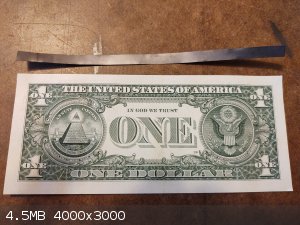
After some HV electrode action holding Pt bits, arcing in atmosphere, they got brittle.
It was suggested at one point, they were boats for evaporation of materials for lense coating chamber. Who knows.
[Edited on 15-10-2020 by violet sin]
|
|
|
1KEE
Harmless

Posts: 25
Registered: 23-2-2020
Member Is Offline
|
|
Here are some photos of a Ta sample along with some lead, titanium and stainless steel for comparison. The color is pretty evident, even when freshly
scratched with a file.
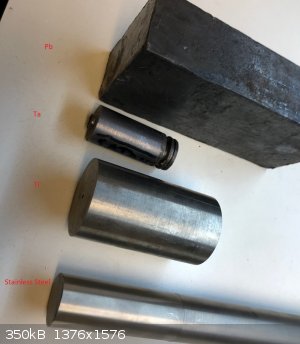
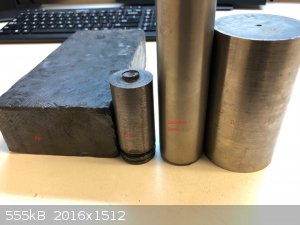
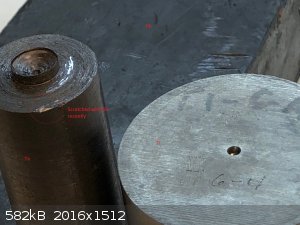
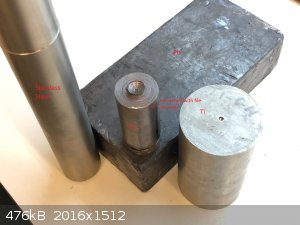
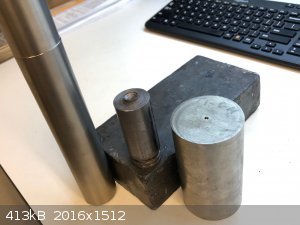
|
|
|
rolynd
Harmless

Posts: 16
Registered: 13-12-2004
Location: At Home
Member Is Offline
Mood: No Mood
|
|
niobium would also be a candidate. see if it anodizes in dilute sulfuric or citric acid thel its likely either Ti, Nb or Ta which at least narrows it
down.
|
|
|
MidLifeChemist
Hazard to Others
  
Posts: 192
Registered: 4-7-2019
Location: West Coast USA
Member Is Offline
Mood: precipitatory
|
|
Quote: Originally posted by rolynd  | niobium would also be a candidate. see if it anodizes in dilute sulfuric or citric acid thel its likely either Ti, Nb or Ta which at least narrows it
down.
|
And If I'm not mistaken, Ti should give a blue or violet solution with Hydrochloric acid, Nb and Ta most likely will not.
|
|
|
Mateo_swe
National Hazard
   
Posts: 505
Registered: 24-8-2019
Location: Within EU
Member Is Offline
|
|
Are you sure its pure and not a alloy?
If its an alloy it would be very hard to determine the without some fancy equipment.
|
|
|
Fantasma4500
International Hazard
    
Posts: 1677
Registered: 12-12-2012
Location: Dysrope (aka europe)
Member Is Offline
Mood: dangerously practical
|
|
take the solution where you dissolved some of it in acid and react that with sodium carbonate to precipitate out a carbonate and see what that looks
like
|
|
|
j_sum1
Administrator
       
Posts: 6218
Registered: 4-10-2014
Location: Unmoved
Member Is Offline
Mood: Organised
|
|
Update.
I found my strips of Ta in a different location, correctly labelled.
I also found a label that had fallen off suggesting the strips are Ni. I am not fully convinvced: I would have expected a reaction between Ni and hot
conc HCl. I would also expect a greenish colour typical of Ni(II) to be produced with the nitric acid. They are however magnetic. That pretty much
narows it down to some kind of stainless steel, Co or Ni. I doubt it is Co. I will do a test for Fe3+ ions later to rule that out. And then I guess
I need to learn a bit about nickel.
|
|
|
violet sin
International Hazard
    
Posts: 1475
Registered: 2-9-2012
Location: Daydreaming of uraninite...
Member Is Offline
Mood: Good
|
|
I'm pretty sure I sent you... Yep I sure did back in 2015.. 14-3-2015
"so far I have ~90g Te, ~25g Ta, ~25g Ni and ~5g Mo. thinking about looking for some others if I have time"
" the tantalum is a bit interesting. it is soft and bendy, darker grey almost bluish metal strips. they are inert in the things I tried them in. I did
get some whitish corrosion when used as test electrodes with a neon sign transformer for NO(x) production experiments"
The Ta was undoubtedly in the form I posted a couple replies up. I received some Ni strips from someone else were handed out free.
|
|
|
j_sum1
Administrator
       
Posts: 6218
Registered: 4-10-2014
Location: Unmoved
Member Is Offline
Mood: Organised
|
|
Thanks VS.
I think the problem is solved.
I have been able to do quite a bit of sorting out in the lab over the past few days: including in the element collection. It is good to know that my
labelling practices are not fully disastrous. 
And yes, the Ta strips are lovely. The surface is quite different from teh nickel in spite of the fact that the sample dimensions are very similar.
|
|
|